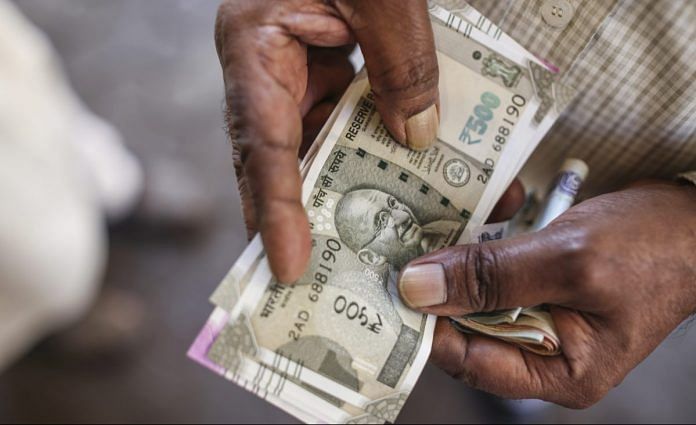New Delhi: The Indian economy experienced contraction for the fifth time in its post-independence history, shrinking by 23.9 per cent of the gross domestic product (GDP) in the April-June quarter. It was led by a sharp contraction in construction, manufacturing and transportation.
While the markets have been reopened, the coronavirus pandemic is still raging on and private consumption has seen one of the steepest falls (26.7 per cent in the April-June quarter).
For this week’s YourTurn, we asked our readers: What more does the government need to do to revive Indian economy?
Here is what some of them said:
‘Government needs to create more jobs’
Unemployment plays a major role in affecting the GDP of a country. The unemployment rate, highest in 45 years, was a problem even before the coronavirus pandemic struck. The government needs to produce more jobs according to the needs of people. It also depends on government’s policy towards various sectors. Only agriculture sector has done some good, otherwise all sectors are facing problems.
Economy is down in almost every big country but compared to countries of its level, India is in the last position. If government can’t increase the GDP, then at least they should try to minimise its contraction.
— Ankit Yadav, New Delhi. Twitter handle: @KaRmaWillPaY
‘Re-strategise economic policy for new growth drivers’
That the Indian economy is caught in a slowdown is beyond doubt. GDP growth rate has declined for four consecutive quarters. Economic policy has to be re-strategised to find new potential drivers of growth. These are some of the measures government can take:
- Integrated multi-sector infrastructural projects with the goal to improve overall quality of life
- Healthcare to focus on an expanded primary healthcare network, multi-functional infrastructure, national health protection coverage and adoption of digital tech
- Strengthening rural infrastructure to promote growth of agro-based industries, better access to markets for farmers and creation of job opportunities for the rural population
- Digital infrastructure for business continuity and continued focus on optical fibre deployment
- Labour reforms to enable performance
- Centre-state alignment on identified policy changes and sectoral reforms
Re-prioritisation and strong implementation, building future-ready infrastructure holds the key to reviving economy and getting back on the growth agenda.
 Sandeep Wanchoo, Gurgaon. Twitter handle: @swanchoo
Sandeep Wanchoo, Gurgaon. Twitter handle: @swanchoo
‘Increase demand and purchasing power of consumers’
The Indian economy has been contracting since the last few quarters even before Covid-19 came. The lockdown due to Covid-19 resulted in further contraction of up to 23.9 per cent in GDP. In my opinion, the economy will be in a better position only when end consumers will spend more, but right now consumers are spending money more rationally because millions have lost their jobs and million others are in constant fear of losing their job anytime.
It is like a cycle which has hit the pause button. To continue the cycle, it is important to increase the demand and increase the purchasing power of consumers at the same time by giving money directly to the people or indirectly by creating jobs, so they can start spending money on things which are less essential. It took two to three years for the economy to crash this bad and certainly it will take more time to get back on track.
 Pranay, Jaipur. Twitter handle: @Pranay1707
Pranay, Jaipur. Twitter handle: @Pranay1707
‘Government needs to provide skill-based education’
For the growing population in India, real economy resides in each family of the nation. That’s why per capita income matters. It is the average income earned per person in a given area in a specified year. When per capita income increases, nation’s productivity also increases and thus our economy. For this, each and every member of a family possessing labour potential (not including children and aged people) need to work, irrespective of whether they are men or women. But today, even though people possess education, they lack skills. They lack opportunity too because our education is not based on vocational skills.
Unemployment will destroy the backbone of a nation. That’s why the government needs to create more job opportunities, especially for young talent. The government needs to provide skill-based education and provide more internships and so on to help students achieve their dreams. If a family is self-sufficient, then a nation’s economy is self-reliant too.
 Aparna
Aparna
‘Disinvestment, labour reforms & simplification of GST’
Disinvestment, labour reforms and simplification of GST should be on the government’s agenda. Since India is facing an unprecedented economic crisis due to the Covid-19 pandemic, it is also a great opportunity to introduce far-reaching reforms. As Littlefinger from the hit HBO series Game of Thrones puts it: “chaos is a ladder”. The government should really press the accelerator on disinvestments, which will generate revenue that the government can use to increase its expenditure, implement labour reforms to liberate the manufacturing industry, and help create more jobs. Finally, the GST rate slabs should be condensed to two rates. This will simplify it to help generate more tax revenues.
— Vidyuth Chikoti, San Francisco Bay Area. Twitter handle: @followvidyuth
‘Focus on providing skilled labour and not cheap labour’
With the global decline in the economies of the world, India’s GDP has also dropped but more than expected. In a crisis like this, the government has the sympathies of the masses. It is the perfect opportunity for them to disguise prior policy failures.
We rely heavily on manual labour and we barely have any automation in our industries. The mass emigration of manual labourers was bound to make a dent in the economy. I believe this is the best opportunity to make fundamental changes and to focus on providing skilled labour and not cheap labour. Government should undertake a joint venture with the private sector to dedicate a part of the year to improve the skills of the existing work force. We need a long term radical plan and not a band aid to heal this injury.
— Dr Swanit Deshpande. Twitter handle: @swanitdeshpande
‘Treat waste as revenue-generating resource’
India produces 277 million tonnes of municipal solid waste every year, out of which only 5 per cent is being recycled. India, itself, generates close to 26,000 tonnes of plastic waste and more than 5 lakh tonnes of wet waste a day. One kg of plastic can be recycled into 1 litre of fuel, and 1 tonne of wet waste can be recycled into biogas equivalent to 2 LPG cylinders (14.2kg). If India starts seeing waste as revenue, and sets up proper infrastructure to recycle and manage it, it will be beneficial for us not just in terms of revenue, but will also contribute towards a clean and green India.
— Sunny Kumar, Patna. Twitter handle: @sunnywithfacts
‘Increase domestic demand, private investment, corona bonds’
A few ideas for the government to consider:
1. Government can increase domestic demand in the economy, akin to the ‘eat out’ scheme recently launched in the UK. Under the ‘Eat Out to Help Out’ scheme, the UK government subsidised meals (food and non-alcoholic drinks only) at restaurants by 50 per cent, from Monday to Wednesday every week, in August.
2. Government can increase private investment by starting projects like constructing roads, bridges etc.
3. Government can issue bonds like corona bonds issued by European Union countries
4. Government can focus on labour reforms, quicker approvals, reducing the compliance burden, and promoting export-oriented sectors.
 Kanishk Singh, Varanasi. Twitter handle: @kanishks222
Kanishk Singh, Varanasi. Twitter handle: @kanishks222
‘Invest in construction works like small-check dams’
The government should focus on increasing its expenditure on constructive works like building of small-check dams. Two targets could be achieved by this step: employment, and in states like Bihar, where people are suffering from severe floods and ill-constructed dams, these structures could provide huge relief. Incentives should be provided in the agricultural sector, and production should be done by keeping in mind the present domestic demands — food grains and not guns, for example. Long story short — our government needs to spend more, but wisely.
 Urmila Kumari. Twitter handle: @ saltygemini
Urmila Kumari. Twitter handle: @ saltygemini
‘Govt needs to import less, export more’
To revive the economy of India, government need to boost the manufacturing sector. Mobile phones and electronic products are not actually made in India but are only assembled in India. India needs real ‘Made in India’ products. India is the leading supplier of medicines but still dependent on China for API (active pharmaceutical ingredients). India needs to produce API on its own. The Indian pesticide industry is also highly dependent on imports for the raw materials. India is one of the biggest consuming countries. And it’s high time that it appreciate its manufacturing units.
 Binni Kumari, Patna. Twitter handle: @Binnikumari9
Binni Kumari, Patna. Twitter handle: @Binnikumari9
Also read: Reader View: Filmmakers can change historical facts, but within reason


TS Darbari – The Indian economy experienced contraction for the fifth time in its post-independence history, shrinking by 23.9 per cent of the gross domestic product (GDP) in the April-June quarter. It was led by a sharp contraction in construction, manufacturing and transportation. While the markets have been reopened, the coronavirus pandemic is still raging on and private consumption has seen one of the steepest falls (26.7 per cent in the April-June quarter). Therefore, such packages are mandatory to boost the economy. Unemployment plays a major role in affecting the GDP of a country. The unemployment rate, highest in 45 years, was a problem even before the coronavirus pandemic struck. The government needs to produce more jobs according to the needs of people. It also depends on government’s policy towards various sectors. Only agriculture sector has done some good, otherwise all sectors are facing problems. #TS_Darbari #Ts_Darbari_Blog #TS_Darbari_News #Ts_Darbari_Views #Ts_Darbari_Blogger #TS_Darbari_Comments #Ts_Darbari_Opinion #About_TS_Darbari #TS_Darbari_Articles #Politics #Views #Comments
Mr. TS Darbari is a top management professional, with several years of rich & diversified experience in Corporate Strategy, New Business Development, Sales & Marketing, Commercial Operations, Project Management, Financial Management and Strategic Alliances’.
Good initiative by The Print. This space may throw up some practical actions to steady the economy. Let us watch…
My two bit…
Sure, we can never stop looking for utopia. But seeking utopia should not be at the cost of living in the present. I find in majority programs in the media, importantly the business media, it is always what more can others (e.g. Government) do for the people and businesses. Before you pull out your political daggers, let me say this is what I have been seeing during the 45 odd years of my adult life (post School). A constant lament. A perpetual wait for GODot.
There is seldom any discussion in media as to how to live in the present and make the best use of available resources. And now….It is a pandemic!!! Life can’t be the usual. Also, you can’t win a race constantly looking over your shoulders. Change the way you think. You will not find answers in the text books.
It is not as if India is a laggard in comparison to the rest of the word. These days here is the US too in spite of all the “stimulating actions” including printing and distributing three trillion dollars (Let us face the truth – India does not have the luxury of such resources), it is “dil maange more”. The US economy is not sprinting away to the finish. In relative performance it is as good or as bad as the Indian economy.
Probably, India still has some dry powder.